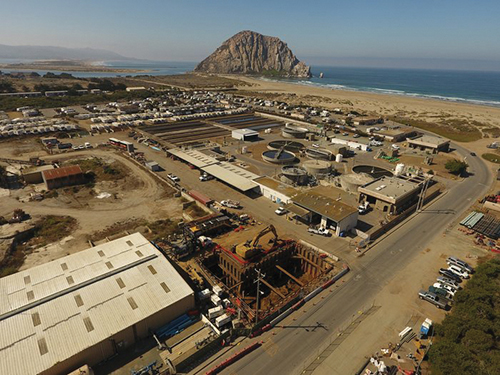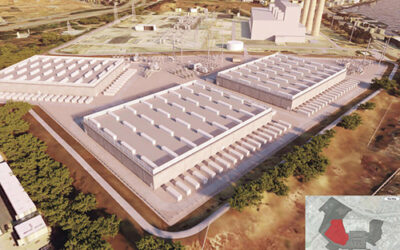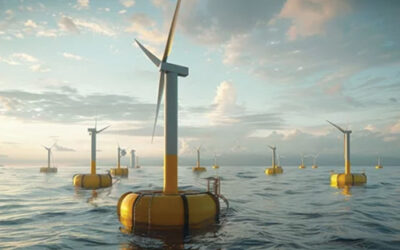A September 2021 aerial drone photo taken by Anvil showing the big dig on Atascadero Road for a new lift station.
It’s the biggest public works project in Morro Bay’s history and now, after nearly four years, the contracts for the Water Reclamation Facility or WRF have been settled.
According to a report by Public Works Director Greg Kwolek, all outstanding issues with the City’s contractors — Filanc/Black & Veatch (FBV) — have been ironed out. Also completed is the contract with Anvil Builders, the company that installed some 3.5 miles of conveyance piping, and built two new lift stations to send the raw sewage out to the new treatment plant, located above the northern terminus of South Bay Boulevard.
Treatment Plant
The new treatment plant and recycling facility, called the Water Reclamation Center or WRC, cost a lot more than initially thought, but the City was able to keep it under its latest amended budgeted amount.
“The City’s current budget for the construction of the WRC is $79,123,216,” Kwolek said. “The $79 million closeout contract value does not exceed the City’s budgeted construction amount for the WRC.”
The WRC has been finished since last fall but the two sides had some issues to work out, increased costs potentially totaling over $2.4 million. The city appears to have gotten off fairly cheaply in the negotiations.
The “City has negotiated final resolution of $2,422,876.46 in outstanding potential change orders from FBV for a payment of $575,674,” Kwolek said.
So with a budget of $79 million, cutting down on the change orders and claims made by FBV, they saved “about $1,800,000 in settlement of all outstanding PCOs from FBV.”
The original contract for the treatment plant was closer to $68 million but the project ran into difficulties almost from its start in March 2020.
In May 2020, heavy rains caused a significant landslide on the site, an event that added nearly $300,000 to the costs.
There was also a major burglary at the plant site, the largest theft case in town history, with over $150,000 worth of tools and construction materials vanishing from the WRF site in March 2021.
Anvil Builders also had one of its storage containers sitting on Quintana Road hit at the same time. Those cases were never solved.
They also had some issues with plant start-up, as the initial sludge brought in to start the biological treatment of wastes didn’t take.
“Initial seed sludge biology,” Kwolek’s report said, “was significantly weakened due in part to a lack of sufficient food and development of unfavorable water quality conditions.” Translated that means the first batch of microbes brought in to activate the digesters all died and seeding the biological part of the treatment process had to be done over. Then last October they had another incident.
“On Oct. 11, 2023,” the report said, “there was a slug of poor quality raw wastewater from the City’s existing plant that overwhelmed and killed the biology at the WRC requiring a re-seeding of the plant.” The report lists the issues with the sludge at $125,000.
The State Department of Drinking Water (DDW) caused the most costly overrun. “The Department of Drinking Water,” the report said, “required additional testing in two phases for the UV [ultraviolet] system of the WRC.”
The plant uses ultraviolet light to disinfect the wastewater before it is discharged into Estero Bay or further filtered through a reverse osmosis plant for eventual recycling. DDW’s extra testing was listed at $1.38 million.
Mother Nature also struck a blow. “The 2022-2023 rainy season proved to be an above average rainfall event for the City of Morro Bay.” Cleaning up and making repairs after the big storm was listed at $181,000.
The big Jan. 9, 2023 storm that flooded a big swath of Main Street hit the new treatment plant too, causing “significant erosion and structural damage to the newly constructed V-ditch drainage system.” That drainage system runs down the side of the new plant. FBV re-designed the ditch and made repairs.
“FBV made design improvements to prevent any back channeling erosion of the V-ditch foundation,” the report said, “and to improve the soil and structure interface of the drainage feature. FBV re-hydro seeded the hillside as well as installed a temporary irrigation system to ensure that the hydro seed established. It should be noted that the V-ditches have currently not had any issue during the rainy season this year.” FBV sought over $669,000 to do this work.
Also, the drainage ditch had a gap in the fencing and FBV was asked to plug the gap with a welded wire mesh screen, which they sought $80,000 for.
FBV had been awarded a design-build contract meaning that the company, a partnership between Filanc and Black & Veatch, designed the whole plant and then built it, too. Carollo Engineering was hired as project managers to watchdog the project and try and keep it going and on budget.
With a final price tag of $79 million, it actually comes in some $123,000 “under budget” as the City’s new budget was $79.1 million. That’s about $10 million above the original bid of $69 million. There were a total of 10 contract amendments made for the treatment plant.
Conveyance System
The City has also closed out its contract with Anvil Builders, the Bay Area company brought in to install needed pipes and lift stations.
Here too the project had unforeseen cost overruns, which the City negotiated and settled in its favor as well.
Anvil’s original bid was for $31 million and the final cost is over $37.2 million. The contract had nine amendments and when the pipes were all laid and the new sewer system up and running, the company was still trying to get over $2.5 million in overages.
“Anvil currently has unresolved change orders and claims submitted to the City for the Conveyance Facilities,” reads another report from Public Works Director, Kwolek, “totaling $2,586,370. Amendment No. 9 and the proposed settlement agreement with Anvil builders closes out all change orders and claims for the Conveyance Facilities Project for $880,000.”
That doesn’t include another $200,000 the City is withholding while it works out a solution to a nagging problem discovered by the heavy winter rains last year, its brine disposal line can’t handle all the flow to the plant.
It’s long been an issue in town that with wet winters and heavy storms, infiltration by groundwater into the sewer lines greatly increases the flow to the plant, by almost double at times.
A persistent issue with the City’s old sewer treatment plant, it cropped up with the heavy winter last year and is apparently still unresolved. The report says there is “a $200,000 retention by City pending outfall hydraulic final resolution concerning brine line effluent pipeline.”
With this ninth contract amendment, Anvil’s final payout totals $37.2 million.
But it could have been worse. “Anvil originally submitted a claim for $4.2M for additional compensation for changes in the scope of the project work,” the report said. “With this Amendment No. 9 and Amendment No. 8, already approved by the Council at the May 27, 2023, meeting, the total being approved for all final claims is $2.3M.”
Breaking down Anvil’s portion the original bid was for $31.4M. The first approved conveyance system construction budget was at $34.7M; and contract Amendments 1-8 added $4.8M.
Amendment No. 9 for $880,000 for final settlement of change orders brought it up to $37.2M.
The City transferred $123,000 it “saved” from the treatment plant portion to the conveyance contract to cover some of Anvil’s extra charges and it used up over $2.4M from the overall project budget, too.
But still outstanding is that sticky problem with the discharge system.
“As to the brine line effluent pipeline,” the report said, “$200,000 in retention will be withheld by the City pending the outcome of the investigation of the conveyance capacity problem. If, after considering that investigation City determines, in good faith, the conveyance capacity problems were caused, in whole or in part, by construction defects, then City will continue to withhold the $200,000 in retention until Contractor remedies the problem to the satisfaction of the City, then release such withheld retention to Contractor, in accordance with City’s payment process.
“If City, after considering the investigation, in good faith determines the problem was not caused by construction defect, then City will release withheld retention to Contractor, in accordance with City’s payment process.”
Recycling Water
Though it might seem that $160 million should surely finish this story, the City is still working on the third major part of this project — actually recycling the treated wastewater.
The City initially intended to recycle some 825-acre feet a year of triple treated (tertiary level) wastewater and then pushed through an RO filtering system.
The plan was to pipe it back into town and inject it into the ground in the Morro Creek Basin to potentially be used for additional drinking water (“indirect potable reuse”) and as a block to potential seawater intrusion.
The City reached a settlement with Vistra, owners of the power plant property, for a utility easement and a well site by Morro Creek. Infrastructure to access that well site was constructed.
The idea of recycling the wastewater played a huge roll in being able to tap a State loan program that provided some $100 million in low-interest loans.
Recently, the City Council and Public Works Advisory Board, at a joint meeting, got a clearer picture of what is required of the project’s recycling portion in order to satisfy the SRF loan.
“At that meeting,” Director Kwolek wrote in a March 12 report, “City Council directed staff to move forward with the recommended initial phase of the Recycled Water Program and initiate environmental, permitting and design activities necessary for program implementation. Included in the motion for approval was an amendment to allow these activities to move forward after the WRF Subcommittee approved a letter prepared by staff to the lending agencies requesting written clarification of the minimum recycled water implementation requirements. In subsequent meetings with the WRF Subcommittee, it was determined that only a letter to the SWRCB DFA was needed as the SRF Loan Agreement was understood to have the most stringent recycled water implementation requirements.”
In a letter to the State Department of Water Resources, which runs the Clean Water State Revolving Fund, Kwolek wrote, “The WRF Program has been a financial pain point for Morro Bay. It is by far the largest public works project ($160m+) the City (pop. 10,700) has ever undertaken. The City has incurred significant costs associated with the property/easement acquisition, environmental mitigation requirements, construction contract change orders, schedule delays, related attorneys fees, a pandemic (i.e., Covid-19 delays and associated labor shortages and supply chain issues), and natural disasters (i.e., historic flooding in winter 2023).”
He sought to clarify the City’s position. “The recycled water usage estimate provided in the City’s SRF application was based on an amount of wastewater available under a future buildout condition. However, we are unsure if the City will ever reach this projected amount within the duration of the SRF loan due to increased water usage efficiency, lower than anticipated population growth rates, and potential future population declines in California. These reductions in water demand and associated reductions in wastewater generation may make it difficult for the City to reach the recycled water usage targets included in the City’s SRF application.”
They didn’t reach a very sympathetic ear. In the State Water Board’s response, Michael Downey, the Acting Assistant Deputy Director Division of Financial Assistance pointed out that the City has more than once listed “indirect potable reuse facilities” in its project specs.
Downey points out that the City back in July 2021 in its agreement for the SRF loan, said the “project scope includes indirect potable reuse facilities, including recycled water pipeline to convey treated water from the Water Reclamation Facility (treatment plant) to the injection location, as well as injection well.”
He adds that this recycled portion of the project made it attractive to the State Water Board. “On Oct. 21, 2020,” Downey wrote, “the City submitted a User Connection Schedule, as part of the application, that detailed an estimated planned recycling water usage of 825 acre-feet per year for both existing and future uses.”
He added that the project’s Plans & Specifications, “submitted by the City with the Final Budget Approval package, for both the WRF and the conveyance phases of construction, set a clear expectation that the City intends to build the project to include Indirect Potable Reuse components.”
He goes on to say under the loan terms, the “eligible project capacity is 825 AFY, 412.5 AFY must be delivered to existing users within 5 years of completion of construction. The remaining 412.5 AFY may be reserved for future use.”
He concludes with a not-so-subtle warning. “Failure to comply with the terms of this agreement may be construed as a material breach of the Agreement,” Downey wrote. “The occurrence of material breach would result in the City’s immediate reimbursement of all grant and loan funds to the State Water Board.”
The City got a $10 million planning grant from the State Water Board to kick off project planning, and later secured the low-interest SRF loan that was combined with a Federal loan under the Water Infrastructure Finance and Innovation Act (WIFIA) and provided the money for the project. The City still has some $9.4 million to be used for the recycling portion.
Long, Winding Road
The origins of this whole saga wind back to 2003, when the City and its former partner, the Cayucos Sanitary District, received a letter from the Regional Water Quality Control Board asking that the old sewer plant on Atascadero Road be upgraded to full secondary treatment.
The water board wanted to get rid of a 301-h permit under the Clean Water Act. That permit allowed for a mix of primary and secondary treated wastewater to be discharged into the ocean south of Morro Rock in about 120-feet of water.
This was done rarely by the plant, which was completely rebuilt in the early 1980s. The permit was needed for times with very high flows, like summer holiday weekends when both towns are packed with tourists.
The first iteration of a project was to add to the existing plant the necessary capacity to properly treat all that extra flow, and continue using much of the plant, at an estimated cost of about $38 million.
Problems arose almost immediately, with some advocating for increased treatment — to tertiary levels. Then FEMA pointed out that the old portions of the plant would be in the flood plain of Morro Creek, so the plans were changed to replace the entire plant using an adjacent property the City owns but is currently being leased to Morro Dunes RV park for storage. That project estimate jumped to about $58 million.
Some 14 different appeals were filed with the Coastal Commission over that project and a push was begun to move it away from the coast and to recycle the water.
Also, a sea change in the makeup of the City Council occurred during the over 2 years the project languished at the Coastal Commission, with the new majority favoring tearing up the plans and moving the plant.
The notion of future reuses of the beachfront property, once the sewer plant was moved, also began to be explored.
The Coastal Commission denied the project at the behest of the new Mayor, and ordered it to be moved inland somewhere to avoid “coastal hazards,” i.e. tsunamis, and flooding; and to address climate change and sea level rise.
The Coastal Commission suggested the Righetti Ranch, a sizable ranch property on Hwy 41 at the eastern edge of the City Limits, would be a good site.
That idea was estimated to add millions to the project to pay for piping the water a little over a mile, to a new treatment plant.
But an appraisal of the ranch came in too far below the asking price, and a deal couldn’t be struck. Also, residents on a hillside overlooking the ranch protested and threatened to sue the City to stop it.
The next site was just down the road at the Rancho Colina MHP and RV Park. The City also started considering moving its corporation yard there too. But negotiations on that property also broke down and the City started looking at numerous other properties, including potentially going south to Toro Creek Road.
During all this, the relationship with Cayucos broke down and the CSD divorced itself from a partnership with Morro Bay on a new plant, and instead built its own treatment plant on Toro Creek Road. That plant opened years before Morro Bay’s and cost less than $30 million.
The City Council investigated dozens of potential new sites and settled on the South Bay Boulevard site, as it had the fewest detractors and seemed the safest place politically. This new site required an array of conveyance pipes to be installed running about 3.5 miles out to the new plant, plus two new lift stations had to be built.
The project has seen countless political struggles, and been shaped by the growing issue of addressing climate change. It has pit friends and neighbors against each other, brought environmental activists to town arguing for one treatment method or another, broke up a partnership that went back several decades, and been bounced from location to location, all the while going up in complexity and rising in costs.
A project that started in 2003 is now almost completed in 2024; actually not all that long a time, as sewer projects go.




